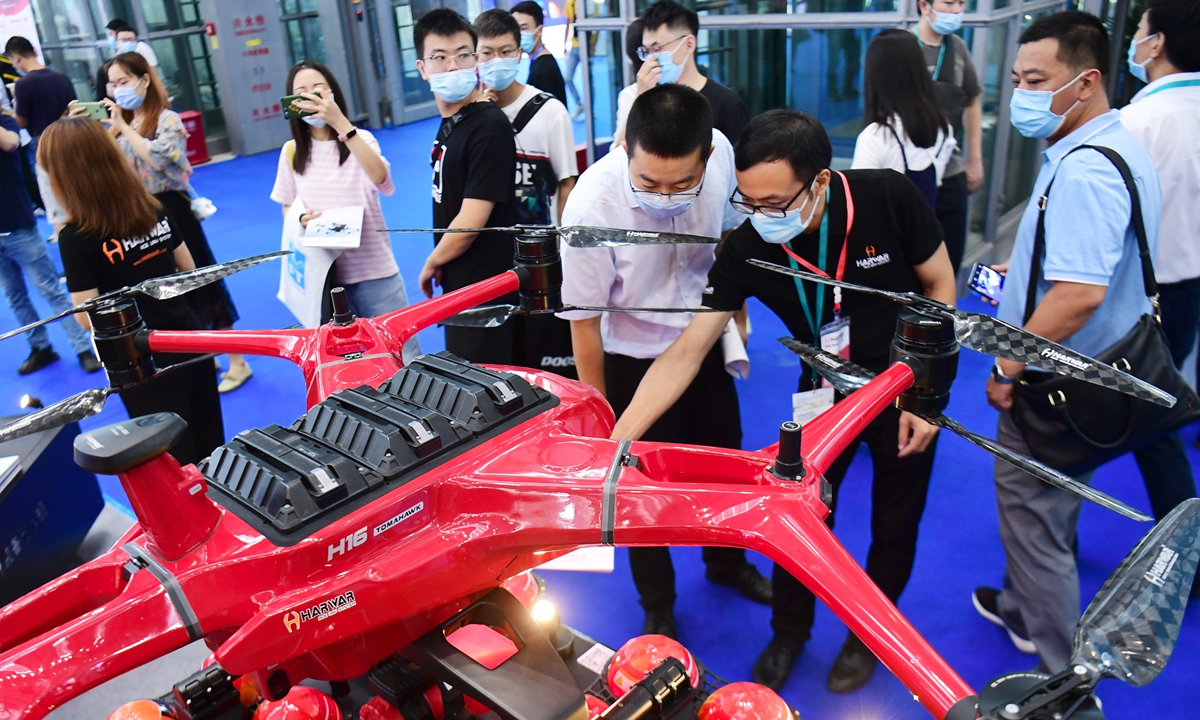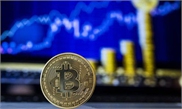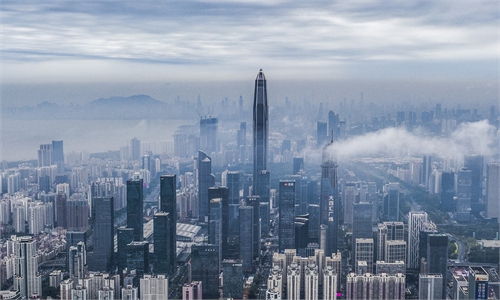
Shenzhen, home of China's high-tech companies, holds a drone exhibition on Sunday. More than 400 domestic and foreign companies brought more than 1,000 drones to show. The China Air Transport Association said that as of the end of 2019, the civilian drone market reached 21 billion yuan, ($3.07 billion), up 56 percent a year-on-year. Photo: cnsphoto
For many Hong Kong youth and entrepreneurs, Qianhai district in southern Shenzhen - which is designed to facilitate greater cooperation between the Hong Kong Special Administrative Region (HKSAR) and the Chinese mainland - is the place where they began to chase dreams.
Now, the central government's detailed plan on Shenzhen is taking their dreams further, opening a wider door for them to leverage Hong Kong's edge in finance and high-tech innovation to integrate into China's development and tap into the massive mainland market.
In the past decades, the two neighbors have been supporting each other, and they will continue to play complementary role in the development of Guangdong-Hong Kong-Macao Greater Bay Area, entrepreneurs said.
A grand meeting celebrating the 40th anniversary of the establishment of the Shenzhen Special Economic Zone (SEZ) was held on Wednesday in Qianhai, with Chinese President Xi Jinping delivering a speech, noting that China will actively promote and deepen the construction of Greater Bay Area. This marks the third time Xi has visited the area after inspecting it in 2012 and 2018, respectively.
Ahead of the visit, China unveiled a plan to implement pilot reforms in Shenzhen which are aimed at building the city into a demonstration area of socialism with Chinese characteristics over the next five years.
Driving across Qianhai, one of the most eye-catching banners reads, "serving the Chinese mainland based on Hong Kong and opening up to the world." To date, 12,000 Hong Kong companies have set up business units in the pilot area, HKSAR Chief Secretary Matthew Cheung Kin-chung was quoted as saying in media reports.
Many Hong Kong businessmen have adopted a "twin-city" strategy, moving some of research and development (R&D) as well as production to Shenzhen to take advantage of the city's complete industrial chain and proximity to a 1.4-billion consumer market.
Henry Yau, a Hong Kong resident who founded the Shenzhen intelligent lighting company Everbright Technology Development in Qianhai, is one of those businessmen who have benefited from such strategy. After setting up the company in Qianhai in 2016, he has also opened laboratories and factories in Guangdong's Dongguan, Zhongshan and Foshan in recent years.
Yau believed that the detailed plan will not only usher Shenzhen's development in a new era but also that of Hong Kong, offering more job opportunities for Hongkongers and attracting more Hong Kong youth to the Chinese mainland.
"Shenzhen's development will also help alleviate Hong Kong's employment pressure and social conflicts," Kris Tsang, founder of Shenzhen-based 708090 Co-working Space, told the Global Times on Wednesday. He urged Hong Kong's young generation to seize the "golden opportunity" of Greater Bay Area and fully utilize their talents and advantages to participate in the area's construction.
In 2019, Hong Kong experienced months-long social unrest that sank its economy to a record low. But the implementation of the national security law for Hong Kong this year has partly helped the metropolis restore order and stability.
Elaine Shiu Yin Ning, executive director of jewelry-maker Ejj Holding, told the Global Times that despite the turmoil, Hong Kong still plays an "unprecedented and irreplaceable" role in helping Shenzhen attract international talents, providing professional financial service and international insights for the neighbor.
"We really look forward to more, deeper high-level cooperation in the Greater Bay Area. Some Hong Kong youths' perceptions on the Chinese mainland are biased and limited. If they communicated more with the Chinese mainland, they will definitely clear such misunderstanding. It will arouse their patriotism and sense of belonging to the motherland," Shiu said.
In 2018, Shenzhen's GDP surpassed its neighbor Hong Kong for the first time. In a recent interview with Shenzhen TV station, HKSAR Chief Executive Carrie Lam said the central government's innovative policies on Shenzhen will open a new chapter in the cooperation between Shenzhen and Hong Kong.
In the past four decades, Hong Kong played a pivotal role in the development of Shenzhen, providing capital, technology and management experiences. And Shenzhen's rise also cements Hong Kong's position as a global financial and trading hub, analysts said.
"Both cities have their roles to play in the Greater Bay Area. And they will continue to support each other in the future, just as they stood by each other in the past," Tsang said.




